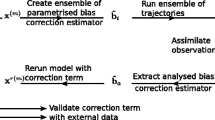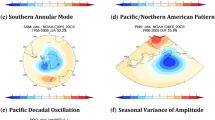Abstract
Model error is a major obstacle for enhancing the forecast skill of El Niño-Southern Oscillation (ENSO). Among three kinds of model error sources—dynamical core misfitting, physical scheme approximation and model parameter errors, the model parameter errors are treatable by observations. Based on the Zebiak-Cane model, an ensemble coupled data assimilation system is established to study the impact of parameter optimization (PO) on ENSO predictions within a biased twin experiment framework. “Observations” of sea surface temperature anomalies drawn from the “truth” model are assimilated into a biased prediction model in which model parameters are erroneously set from the “truth” values. The degree by which the assimilation and prediction with or without PO recover the “truth” is a measure of the impact of PO. Results show that PO improves ENSO predictability—enhancing the seasonal-interannual forecast skill by about 18 %, extending the valid lead time up to 33 % and ameliorating the spring predictability barrier. Although derived from idealized twin experiments, results here provide some insights when a coupled general circulation model is initialized from the observing system.














Similar content being viewed by others
Abbreviations
- EAKF:
-
Ensemble adjustment Kalman filter
- SE:
-
State estimation
- PO:
-
Parameter optimization
- CTL:
-
Model control run
- ENSO:
-
El Niño-Southern Oscillation
References
Aksoy A, Zhang F, Nielsen-Gammon JW (2006) Ensemble-based simultaneous state and parameter estimation in a two-dimensional sea-breeze model. Mon Weather Rev 134:2951–2970
Anderson JL, Anderson SL (1999) A Monte Carlo implementation of the nonlinear filtering problem to produce ensemble assimilations and forecasts. Mon Weather Rev 127:2741–2758
Anderson JL (2001) An ensemble adjustment Kalman filter for data assimilation. Mon Weather Rev 129:2884–2903
Anderson JL (2003) A local least squares framework for ensemble filtering. Mon Weather Rev 131:634–642
Anderson JL (2007) Exploring the need for localization in ensemble data assimilation using a hierarchical ensemble filter. Phys D 230:99–111
Anderson JL (2008) Spatially and temporally varying adaptive covariance inflation for ensemble filters. Tellus 61A:72–83
Annan JD, Hargreaves JC, Edwards NR, Marsh R (2004) Parameter estimation in an intermediate complexity earth system model using an ensemble Kalman filter. Ocean Model 8:135–154
Banks HT (1992a) Control and estimation in distributed parameter systems. In: Frontiers in applied mathematics, vol 11. SIAM, 3600 University City Science Center, Philadelphia, Pennsylvania pp 19104–2688
Banks HT (1992b) Computational issues in parameter estimation and feedback control problems for partial differential equation systems. Phys D 60:226–238
Bishop CH, Hodyss D (2007) Flow adaptive moderation of spurious ensemble correlations and its use in ensemble-based data assimilation. Q J R Meteor Soc 133:2029–2044
Cane MA, Zebiak SE, Dolan SC (1986) Experimental forecasts of El Niño. Nature 321:827–832
Chen D, Cane MA (2008) El Niño prediction and predictability. J Comput Phys 227:3625–3640
Chen D, Zebiak SE, Busalacchi AJ, Cane MA (1995) An improved procedure for El Niño forecasting: implications for predictability. Science 269:1699–1702
Chen D, Cane MA, Zebiak SE, Canizares R, Kaplan A (2000) Bias correction of an ocean-atmosphere coupled model. Geophys Res Lett 27:2585–2588
Chen D, Cane MA, Kaplan A, Zebiak SE, Huang D (2004) Predictability of El Niño over the past 148 years. Nature 428:733–736
Cheng Y, Tang Y, Jackson P, Chen D, Deng Z (2010) Ensemble construction and verification of the probabilistic ENSO prediction in the LDEO5 model. J Clim 23:5476–5497
Evensen G (1994) Sequential data assimilation with a nonlinear quasi-geostrophic model using Monte Carlo methods to forecast error statistics. J Geophys Res 99:143–162
Evensen G (2007) Data assimilation the ensemble Kalman filter. Springe Press, Berlin, p 187
Gaspari G, Cohn SE (1999) Construction of correlation functions in two and three dimensions. Q J R Meteor Soc 125:723–757
Gill AE (1980) Some simple solutions for heat-induced tropical circulation. Q J R Meteor Soc 106:447–462
Hamill TM, Whitaker JS, Snyder C (2001) Distance-dependent filtering of background error covariance estimates in an ensemble Kalman filter. Mon Weather Rev 129:2776–2790
Han G, Wu X, Zhang S, Liu Z, Li W (2013) Error covariance estimation for coupled data assimilation using a Lorenz atmosphere and a simple pycnocline ocean model. J Clim 26:10218–10231
Hansen J, Penland C (2007) On stochastic parameter estimation using data assimilation. Phys D 230:88–98
Houtekamer PL, Mitchell HK, Deng X (2009) Model error representation in an operational ensemble Kalman filter. Mon Weather Rev 137:2126–2143
Jazwinski AH (1970) Stochastic processes and filtering theory. Academic Press, New York
Jin EK, Kinter JLIII, Wang B, co-authors (2008) Current status of ENSO prediction skill in coupled ocean-atmosphere models. Clim Dyn 31:647–664
Kaplan A, Cane MA, Kushnir Y, Clement AC, Blumenthal MB, Rajagopalan B (1998) Analyses of global sea surface temperature 1856-1991. J Geophys Res 103:18567–18589
Karspeck AR, Anderson JL (2007) Experimental implementation of an ensemble adjustment filter for an intermediate ENSO model. J Clim 20:4638–4658
Karspeck AR, Kaplan A, Cane MA (2006) Predictability loss in an intermediate ENSO model due to initial error and atmospheric noise. J Clim 19:3572–3588
Keenlyside N, Latif M, Botzet M, Jungclaus J, Schulzweida U (2005) A coupled method for initializing El Niño Southern Oscillation forecasts using sea surface temperature. Tellus 57A:340–356
Kondrashov D, Sun C, Ghil M (2008) Data assimilation for a coupled ocean–atmosphere model, part II: parameter estimation. Mon Weather Rev 136:5062–5076
Laine M, Solonen A, Haario H, Järvinen H (2012) Ensemble prediction and parameter estimation system: the method. Q J R Meteorol Soc 138:289–297
Lee T, Boulanger JP, Foo A, Fu LL, Giering R (2000) Data assimilation by an intermediate coupled ocean-atmosphere model: application to the 1997–1998 El Niño. J Geophys Res 105:26063–26087
Liu Y, Liu Z, Zhang S, Rong X, Jacob R, Wu S, Lu F (2014) Ensemble-based parameter estimation in a coupled GCM using the adaptive spatial average method. J Clim. doi:10.1175/JCLI-D-13-00091.1
Mann M, Cane MA, Zebiak SE, Clement A (2005) Volcanic and solar forcing of El Niño over the past 1000 years. J Clim 18:447–456
McPhaden MJ, Zebiak SE, Glantz MH (2006) ENSO as an integrating concept in earth science. Science 314:1740–1745
Miyoshi T (2011) The Gaussian approach to adaptive covariance inflation and its implementation with the local ensemble transform Kalman filter. Mon Weather Rev 139:1519–1535
Moore AM, Kleeman R (1999) Stochastic forcing of ENSO by the intraseasonal oscillation. J Clim 12:1199–1220
Peng SQ, Li YN, Xie L (2013) Adjusting the wind stress drag coefficient in storm surge forecasting using an adjoint technique. J Atmos Ocean Technol 30:590–608
Penland C, Magorian T (1993) Prediction of Niño 3 sea surface temperatures using linear inverse modeling. J Clim 6:1067–1076
Stainforth DA, Aina T, Christensen C, co-authors (2005) Uncertainty in predictions of the climate response to rising levels of greenhouse gases. Nature 433:403–406
Sugiura N, co-authors (2008) Development of a four-dimensional variational coupled data assimilation system for enhanced analysis and prediction of seasonal to interannual climate variations. J Geophys Res 2008(133):C10017. doi:10.1029/2008JC004741
Vossepoel FC, Van Leeuwen PJ (2007) Parameter estimation using a particle method: inferring mixing coefficients from sea level observations. Mon Weather Rev 135:1006–1020
Whitaker JS, Hamill TM, Wei X, Song Y, Toth Z (2008) Ensemble data assimilation with the NCEP global forecast system. Mon Weather Rev 136:463–482
Wu X, Zhang S, Liu Z, Rosati A, Delworth T, Liu Y (2012) Impact of geographic dependent parameter optimization on climate estimation and prediction: simulation with an intermediate coupled model. Mon Weather Rev 140:3956–3971
Wu X, Zhang S, Liu Z, Rosati A, Delworth T (2013) A study of impact of the geographic dependent of observing system on parameter estimation with an intermediate coupled model. Clim Dyn 40(7–8):1789–1798
Wu X, Li W, Han G, Zhang S, Wang X (2014) A compensatory approach of the fixed localization in EnKF. Mon Wea Rev 142:3713–3733
Yu Y, Mu M, Duan W (2012) Does model parameter error cause a significant “Spring Predictability Barrier” for El Niño events in the Zebiak-Cane model? J Clim 25:1263–1277
Zebiak SE, Cane MA (1987) A model El Niño-Southern Oscillation. Mon Weather Rev 115:2262–2278
Zhang S, Anderson JL (2003) Impact of spatially and temporally varying estimates of error covariance on assimilation in a simple atmospheric model. Tellus 55A:126–147
Zhang S, Harrison MJ, Wittenberg AT, Rosati A, Anderson JL, Balaji V (2005) Initialization of an ENSO forecast system using a parallelized ensemble filter. Mon Weather Rev 133:3176–3201
Zhang S, Harrison JJ, Rosati A, Wittenberg AT (2007) System design and evaluation of coupled ensemble data assimilation for global oceanic climate studies. Mon Weather Rev 135:3541–3564
Zhang S, Liu Z, Rosati A, Delworth T (2012) A study of enhancive parameter correction with coupled data assimilation for climate estimation and prediction using a simple coupled model. Tellus 63A:10963. doi:10.3402/tellusa.v63i0.10963
Zhu Y, Navon IM (1999) Impact of parameter estimation on the performance of the FSU global spectral model using its full physics adjoint. Mon Weather Rev 127:1497–1517
Zupanski D, Zupanski M (2006) Model error estimation employing an ensemble data assimilation approach. Mon Weather Rev 134:1337–1354
Acknowledgments
The authors thank Mark A. Cane and Donna Lee for providing the codes of the ZC model. This research is co-sponsored by grants from the National Natural Science Foundation (41306006, 41376015, 41376013, 41176003, and 41206178), the National Basic Research Program (2013CB430304), the National High-Tech R&D Program (2013AA09A505), and the Global Change and Air–Sea Interaction (GASI-01-01-12) of China.
Author information
Authors and Affiliations
Corresponding author
Rights and permissions
About this article
Cite this article
Wu, X., Han, G., Zhang, S. et al. A study of the impact of parameter optimization on ENSO predictability with an intermediate coupled model. Clim Dyn 46, 711–727 (2016). https://doi.org/10.1007/s00382-015-2608-z
Received:
Accepted:
Published:
Issue Date:
DOI: https://doi.org/10.1007/s00382-015-2608-z




